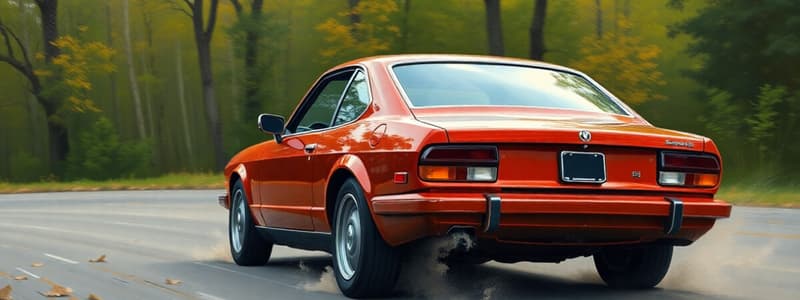Podcast
Questions and Answers
In an oversteering situation, which of the following best describes the relationship between slide force and drive force on the rear tires?
In an oversteering situation, which of the following best describes the relationship between slide force and drive force on the rear tires?
- The slide force is greater than the drive force, causing the rear of the car to lose traction. (correct)
- The drive force is greater than the slide force, resulting in increased acceleration.
- The slide force and drive force alternate, causing the vehicle to pulsate.
- The slide force is equal to the drive force, maintaining stability.
What is the recommended initial steering response when correcting an oversteer, considering the timing of the skid or slide?
What is the recommended initial steering response when correcting an oversteer, considering the timing of the skid or slide?
- Move the steering wheel at the same rate the slide began. (correct)
- Wait for the skid to fully develop before applying any steering input.
- Apply quick, short steering corrections to regain control.
- Steer rapidly in the opposite direction immediately upon noticing the skid.
While experiencing oversteer and pressing on the gas, what adjustment should a driver make to regain rolling traction?
While experiencing oversteer and pressing on the gas, what adjustment should a driver make to regain rolling traction?
- Increase acceleration to stabilize the vehicle.
- Maintain constant pressure on the accelerator.
- Ease off the accelerator to allow the tires to regain traction. (correct)
- Apply the brakes firmly to reduce speed.
If a driver is experiencing oversteer while braking, what is the recommended course of action to balance the forces and regain control?
If a driver is experiencing oversteer while braking, what is the recommended course of action to balance the forces and regain control?
When responding to oversteer, why is it crucial to avoid moving the steering wheel too quickly?
When responding to oversteer, why is it crucial to avoid moving the steering wheel too quickly?
In which weather conditions is oversteer most likely to occur?
In which weather conditions is oversteer most likely to occur?
What does it mean when the rear of the vehicle is 'taking a wider path around the corner than you wish to go'?
What does it mean when the rear of the vehicle is 'taking a wider path around the corner than you wish to go'?
What should be done if the rear wheels lock up while braking during an oversteer situation?
What should be done if the rear wheels lock up while braking during an oversteer situation?
What is the primary goal of adjusting the accelerator or brake during an oversteer situation?
What is the primary goal of adjusting the accelerator or brake during an oversteer situation?
In an oversteering scenario, if applying gas causes the rear wheels to spin beyond the point of optimal traction (incipient spin), what adjustment is necessary?
In an oversteering scenario, if applying gas causes the rear wheels to spin beyond the point of optimal traction (incipient spin), what adjustment is necessary?
Flashcards
Oversteer
Oversteer
A handling characteristic where the rear of the vehicle takes a wider path around a corner than desired.
Steering Response in a Skid
Steering Response in a Skid
Move the steering wheel at the same rate as the slide began to correct.
Correcting Oversteer on the Gas
Correcting Oversteer on the Gas
Reduce the accelerator to help the tires regain rolling traction in an oversteering situation.
Correcting Oversteer on the Brakes
Correcting Oversteer on the Brakes
Signup and view all the flashcards
Study Notes
- Oversteer is a handling characteristic where the rear of the vehicle is unresponsive, whether braking, accelerating, or coasting.
- Oversteer is defined as the rear of the vehicle following a wider path around a corner than desired.
- Oversteer commonly occurs in rain, ice, or snow.
- Skids or slides develop gradually, but drivers often react too quickly, move the steering wheel no faster than the slide began.
- In oversteer, rear tires exhibit a greater slide force than drive force, causing the rear of the car to take a wider path.
Corrective Actions for Oversteer
- When accelerating, ease off the accelerator to regain rolling traction.
- Easing off the accelerator balances the forces and prevents the rear from coming around faster.
- When braking and experiencing oversteer, ease off the brake and gently accelerate to shift weight to the rear.
- Shifting weight helps regain rolling traction and balance the forces.
Studying That Suits You
Use AI to generate personalized quizzes and flashcards to suit your learning preferences.


